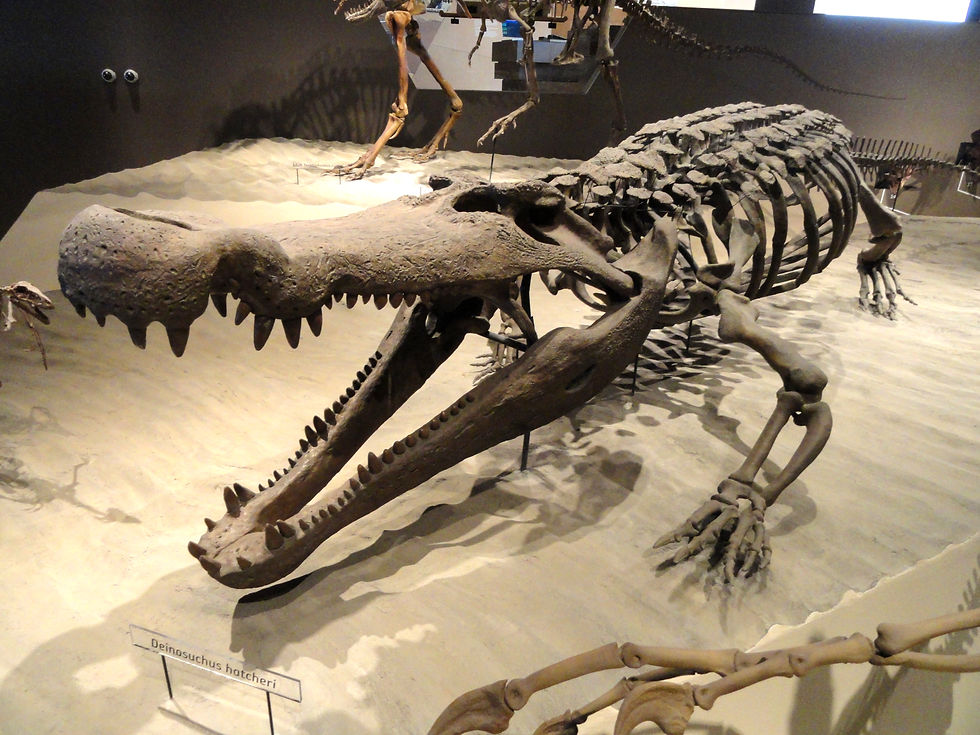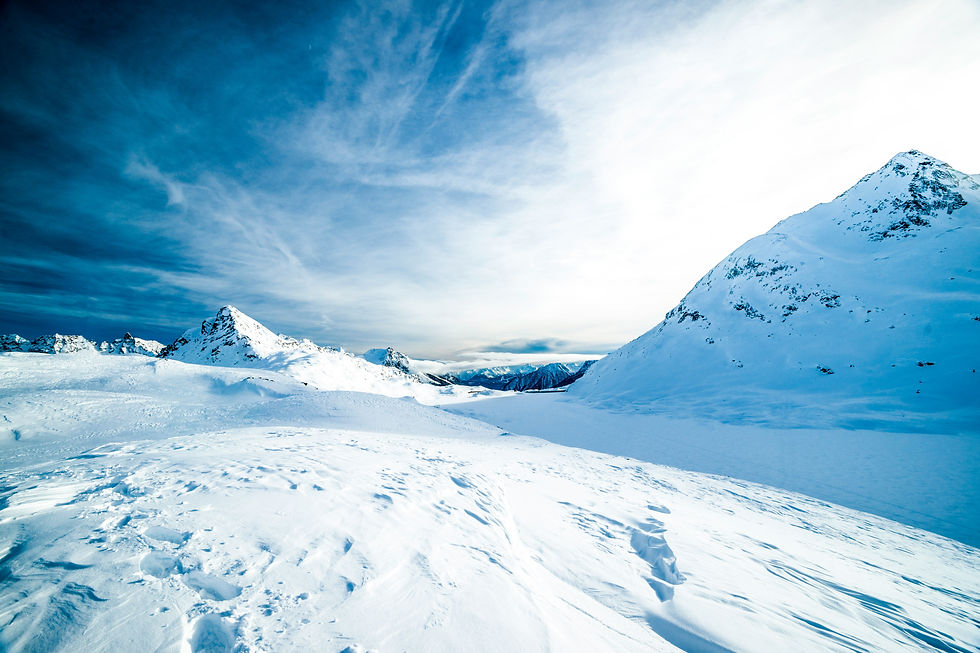Exploring the Fossils of Colorado USA
- Wayne Munday
- Jun 30, 2023
- 5 min read
Updated: Dec 16, 2024
The U.S State of Colorado is known for its geodiversity featuring a wide range of complex geological formations, natural resources, national parks and dinosaur fossils. In April 1982 the Stegosaurus was designated the official Colorado State fossil.

The Stegosaurus (meaning "roofed lizard" or "covered lizard") is one of the most iconic dinosaurs. The Stegosaurus is recognisable by its small head, a huge body weighing up to 5 tons, measuring 4 meters tall and 9 meters in length. They had a powerful upright spiked tail often referred to as a "thagomizer" a term invented by Gary Larson in a Far Side strip in 1982 and probably used for defence. The body of the Stegosaur also had large triangle-shaped bony plates that stood vertically and alternately on either side of their spine stretching from the neck down to its tail.
Even today there is still much debate by researchers as to the purpose and function of these large bony plates. It is unlikely that they were used as a weapon but rather they were multi-functional as a form of defensive armour, a form of display and by the fossil evidence of blood vessels they may have been used as a mechanism to regulate body temperature.
Above is a virtual representation of a Stegosaurus walking and narrated by Sir David Attenborough who explains how these dinosaurs would have moved. This animation is based on the most complete Stegosaurus skeleton ever found. Affectionately dubbed "Sophie", this specimen is on display in London's Natural History Museum - Earth Hall.
The Stegosaurus was a large slow moving herbivorous armoured dinosaur that lived in Colorado during the Late Jurassic between 163.5 – 145 million years ago. The Stegosaurus thrived and their fossil remains have also been found in the United States, Europe, Africa, and in Asia.
First discovered in the North America the Stegosaurus was unearthed in the Morrison Formation in 1877 by M. P. Felch. The Stegosaurus was named by Othniel Charles Marsh an American professor of palaeontology at Yale College and President of the National Academy of Sciences.

Following the end of the American Civil War in 1865 between the Union ("the North") and the Confederacy ("the South") an adversarial rivalry emerged in the emerging field of American Palaeontology that would become known as the “Bone Wars” or "Great Dinosaur Rush".
The two proponents of the Bone Wars were Othniel Charles Marsh and Edward Drinker Cope a member of the Megatherium Club and Professor at the Academy of Natural Sciences in Philadelphia.
During the period between 1877 - 1892 both men invested heavily in the pursuit of paleontological supremacy over the other in a bid to discover dinosaurs in Colorado, Nebraska, and Wyoming. The discovery of the Stegosaur in Colorado would represent one of many skirmishes.
In 1937, High School students and their teacher from Canon City, Colorado discovered a Stegosaurus that is now on display at the Denver Museum of Nature and Science along with fossils of a Edmontosaurus, Maiasaura, Diplodocus, Gargoyleosaurus, Allosaurus, and Othnielia.

It is also interesting to note that the Museum of Natural History at the University of Colorado Boulder also exhibits collections of fossil plants, fossil eggs and fossil tracks.
Colorado's geological history spans over 2.7 billion-years and according to the Colorado Geological Survey during the past thirty years, scientists have unearthed the world’s first articulated Stegosaurus skeleton; three of the world’s four largest dinosaurs; the largest dinosaur trackway in North America; a huge palm forest; one of the world’s most diverse leaf fossil sites; an eight-foot long mammoth tusk; and Tyrannosaurus rex bones.
In Colorado there are three notable fossil rich rock formations including the White River Formation in north east Colorado, the Green River Formation in the north west and the Morrison Formation found in numerous locations around the state.
The White River Formation
The White River Formation is located primarily in the northern Great Plains and central Rocky Mountains region including the north east of Colorado, Dawes County in western Nebraska, Badlands of western South Dakota, and the Douglas area of south east Wyoming.
The fossil record of the White River Formation spans the Eocene epoch dated between 56.0 - 33.9 million years ago. This epoch was the second of the three epochs of the Palaeogene Period preceded by the Palaeocene Epoch that immediately followed the extinction of the dinosaurs.
At the time the Earth's climate was warmer than it is today. Unlike the dry and arid conditions of today the White River Formation would have been formed in a well irrigated landscape of rivers lakes and swamps.
The fossil record of the White River Formation is rich in reptiles, birds, fish, plants and mammals including Oreodonts (ruminating hogs), Equids (horses), Camels, Hyracodons (Rhinoceros), Brontotheres, Hyaenodons, Canids (dogs), Nimravids (false saber-toothed cats), Entelodonts (pigs), Hypertragulids, and carnivores such as the "bear-dog" Amphicyon.

The Green River Formation
The Green River Formation is also dated from 50 million years ago during the Eocene and is primarily found in Colorado, Utah, and Wyoming. It is known for its extensive fossil record of exceptionally preserved fossilised fish as well as insects, plants, birds, reptiles, and mammals.

The Green River Formation was formed when huge quantities of sand, silt, mud and dissolved minerals flowed from the newly created Rocky Mountains into the region’s lakes.
Over time the lakes filled creating swamps and the moist warm climate increased plant growth. A combination of swampy conditions and algae created an environment ideal for the preservation of fossils and overtime coal seams and oil shales formed.
The Morrison Formation
The Morrison Formation is a distinctive geological formation that is widespread across the western United States, including parts of Colorado. It is a sequence of sedimentary rocks that were deposited during the Late Jurassic Period dated from 163.5 to 145 million years ago. The formation is named after the small town of Morrison in Jefferson County, Colorado.
The Morrison Formation is composed of sandstones, mudstones, and limestones that yield dinosaur bones and tracks including the world’s largest and smallest dinosaurs. This formation was deposited in a variety of environments, including floodplains, river channels, and lakes.
The Late Jurassic climate would have been much warmer and more humid than it is today. The ecosystem would have been of a forest and shrubland with rivers and lakes. The dinosaur remains are most likely found in the river channels.
The Morrison Formation is famous for its rich fossil record, particularly its dinosaur fossils as well as plants, invertebrates, and small vertebrates. Many significant dinosaur discoveries have been made within the Morrison Formation, including iconic species of Camarasaurus, Stegosaurus, Allosaurus, Diplodocus, and large, long-necked Apatosaurus.

Illustration depicts four dinosaurs (l-r): Stegosaurus, Apatosaurus (also known as Brontosaurus), Camptosaurus, and Allosaurus. The images are drawn in scale to each other - Image by U.S. National Park Service
In Colorado, the Morrison Formation is exposed in several areas including parts of the Colorado Plateau region, such as Mesa Verde National Park, San Juan Basin and Dinosaur National Monument, located in northwest Colorado and northeast Utah.
Other areas in Colorado rich in fossils include the Florissant Fossil Beds National Monument. There are no dinosaurs to found here but the Florissant fossil beds date to the late Eocene Epoch, approximately 34 million years ago. Florissant Fossil Beds National Monument fossil record includes massive petrified stumps of redwood tree and much smaller fossils insects, spiders, fish, leaves, cones, and seeds.








